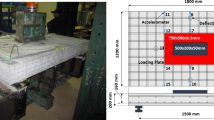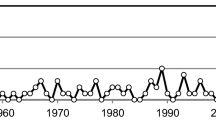Abstract
The structural integrity of corroded reinforced concrete (RC) elements is commonly evaluated by the electrical resistivity method to estimate only the mass loss of reinforcement. It is also possible to evaluate overall deterioration induced by corrosion in the RC elements by examining their nonlinear dynamic behaviors. Therefore, herein, a nonlinear vibration-based diagnostic technique is investigated to measure the magnitudes of higher harmonics of resonance caused due to the corrosion-induced damage in the reinforced concrete. The developed diagnostic technique utilizes an adaptive higher order spectral analysis, which incorporates the wavelet transform instead of the Fourier transform, in order to suit the transit vibration signals generated under an impact hammer. Initially, the algorithm to extract a diagnostic feature, named the wavelet transform-based bicoherence (WTB), is developed on the synthetic vibration signals with different levels of nonlinearity. Then, the developed diagnostic method is demonstrated on two lab-scale RC columns. Comparison of the results obtained by the traditional Fourier-based and the proposed wavelet-based bispectra reveals up to 42.7% improvement in the discrimination of the damaged column from the intact one.













Similar content being viewed by others
References
Addison P (2002) The illustrated wavelet transform handbook: introductory theory and applications in science, Institute of Physics Publishing. CRC Press, Boca Raton
ASTM C597-16 (2016) Standard test method for pulse velocity through concrete. ASTM International, West Conshohocken
ASTM C1383-15 (2015) Standard test method for measuring the p-wave speed and the thickness of concrete plates using the impact-echo method. ASTM International, West Conshohocken
Kirlangic AS, Cascante G, Polak M (2016) Damage assessment of concrete beams with defects using surface waves. ACI Mater J 113(1):73–81
Brownjohn JMW, de Stefano A, Xu Y, Wenzel H, Aktan AE (2011) Vibration-based monitoring of civil infrastructure: challenges and successes. J Civ Struct Health Monit 1(3–4):79–95. https://doi.org/10.1007/s13349-011-0009-5
Das S, Saha P, Patro SK (2016) Vibration-based damage detection techniques used for health monitoring of structures: a review. J Civ Struct Health Monit 6(3):477–507. https://doi.org/10.1007/s13349-016-0168-5
Farrar CR, Hemez FM, Shunk DD, Stinemates DW, Nadler BR, Czarnecki JJ (2004) A review of structural health monitoring literature: 1996-2001. Los Alamos National Laboratory, Los Alamos
Zhu X, Hao H (2009) Damage detection of RC slabs using nonlinear vibration features. Int J Struct Stab Dyn 9(4):687–709. https://doi.org/10.1142/S0219455409003247
Collis WB, White PR, Hammond JK (1998) High order spectra: the bispectrum and trispectrum. Mech Syst Signal Process 12(3):375–394
Courtney CRP, Neild SA, Wilcox PD, Drinkwater BW (2010) Application of the bispectrum for detection of small nonlinearities excited sinusoidally. J Sound Vib 329(20):4279–4293. https://doi.org/10.1016/j.jsv.2010.04.031
Fackrell JW, White PR, Hammond JK, Pinnington RJ (1995) The interpretation of the bispectra of vibration signals. Mech Syst Signal Process 9(3):267–274
Nikias CL, Petropula AP (1993) Higher order spectral analysis. Prentice-Hall, Englewood Cliffs
Chandran V, Elgar S (1994) A general procedure for the derivation of principal domains of higher-order spectra. IEEE Trans Signal Process 42(1):229–233. https://doi.org/10.1109/78.258147
Dong G, Chen J, Zhao F (2015) A frequency-shifted bispectrum for rolling element bearing diagnosis. J Sound Vib 339:396–418. https://doi.org/10.1016/j.jsv.2014.11.015
Jeffries WQ, Chambers JA, Infield DG (1998) Experience with bicoherence of electrical power for condition monitoring of wind turbine blades. IEE Proc—Vis Image Signal Process 145(3):141–148
Parker BE, Ware HA, Wipf DP, Tompkins WR, Ompkins BR, Clarck EC, Larson H, Poor V (2000) Fault diagnostics using statistical change detection in the bispectral domain. Mech Syst Signal Process 14(4):561–570
Sinha JK (2007) Higher order spectra for crack and misalignment identification in the shaft of a rotating machine. Struct Health Monit 6(4):325–334. https://doi.org/10.1177/1475921707082309
Yunusa-Kaltungo A, Sinha JK (2016) Sensitivity analysis of higher order coherent spectra in machine faults diagnosis. Struct Health Monit 15(5):555–567. https://doi.org/10.1177/1475921716651394
Hillis AJ, Courtney CRP (2011) Structural health monitoring of fixed offshore structures using the bicoherence function of ambient vibration measurements. J Sound Vib 330(6):1141–1152. https://doi.org/10.1016/j.jsv.2010.09.019
Xiang Y, Tso SK (2002) Detection and classification of flaws in concrete structure using bispectra and neural networks. NDT E Int 35(1):19–27. https://doi.org/10.1016/S0963-8695(01)00018-4
Jamsek J, Stefanovska A, McClintock PVE (2007) Wavelet bispectral analysis for the study of interactions among oscillators whose basic frequencies are significantly time variable. Phys Rev E 76:046221. https://doi.org/10.1103/PhysRevE.76.046221
Li Y, Wang X, Lin J, Shi S (2014) A wavelet bicoherence-based quadratic nonlinearity feature for translational axis condition monitoring. Sensors 14:2071–2088. https://doi.org/10.3390/s140202071
Van Milligen BP, Hidalgo C, Sánchez E (1995) Nonlinear phenomena and intermittency in plasma turbulence. Phys Rev Lett 74:395–398. https://doi.org/10.1103/PhysRevLett.74.395
Hadjileontiadis LJ (2018) Continuous wavelet transform and higher-order spectrum: combinatory potentialities in breath sound analysis and electroencephalogram-based pain characterization. Math Phys Eng Sci, Philos Trans R Soc A. https://doi.org/10.1098/rsta.2017.0249
Hillis AJ, Neild SA, Drinkwater BW, Wilcox PD (2006) Global crack detection using bispectral analysis. Proc R Soc A: Math Phys Eng Sci 462(2069):1515–1530. https://doi.org/10.1098/rspa.2005.1620
Hinich MJ (1982) Testing for Gaussianity and linearity of a stationary series. J Time Ser Anal 3(3):169–176. https://doi.org/10.1111/j.1467-9892.1982.tb00339.x
Addison P (2002) The illustrated wavelet transform handbook: introductory theory and applications in science, Institute of Physics Publishing. CRC Press, Boca Raton
Rivola A, White PR (1998) Bispectral analysis of the bilinear oscillator with application to the detection of fatigue cracks. J Sound Vib 216(5):889–910. https://doi.org/10.1006/jsvi.1998.1738
Wahab N, Soudki KA (2013) Using osmos FOS to assess corrosion damage in RC columns, pp 148–164. Paper presented at the American Concrete Institute, ACI Special Publication (SP 298)
Acknowledgments
The author thanks Professor Giovanni Cascante from the Department of Civil and Environmental Engineering at the University of Waterloo for providing the test equipment and the test specimens for this research paper.
Author information
Authors and Affiliations
Corresponding author
Additional information
Publisher's Note
Springer Nature remains neutral with regard to jurisdictional claims in published maps and institutional affiliations.
Rights and permissions
About this article
Cite this article
Kırlangıç, A.S. Nonlinear vibration-based estimation of corrosion-induced deterioration in reinforced concrete. J Civil Struct Health Monit 10, 639–651 (2020). https://doi.org/10.1007/s13349-020-00408-1
Received:
Revised:
Accepted:
Published:
Issue Date:
DOI: https://doi.org/10.1007/s13349-020-00408-1




